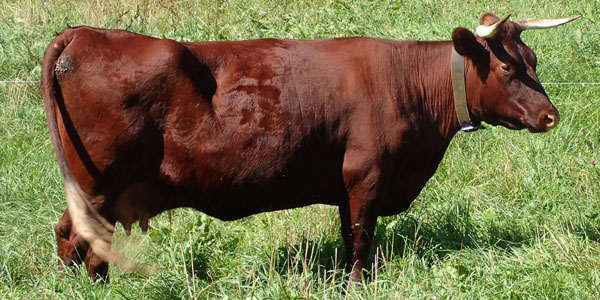
Use or Lose: The Newfoundland Pony
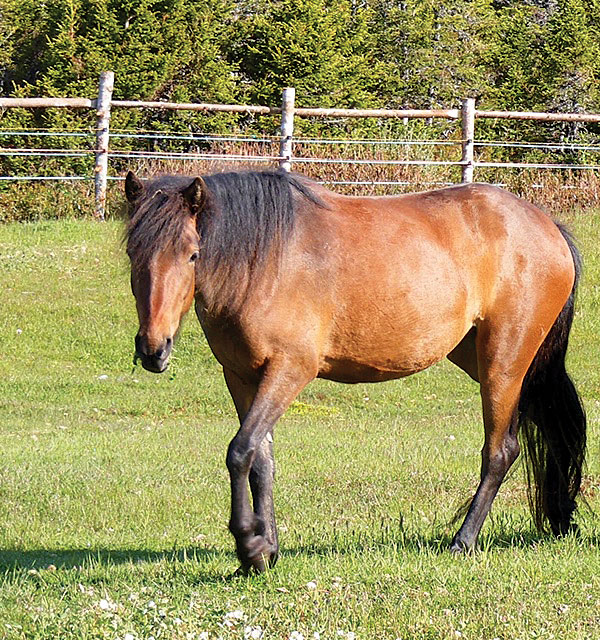
Use or Lose: The Newfoundland Pony
by Caleigh Jerry, photos by Liz Chafe
INTRODUCTION
The population of the world today is very familiar with the concepts of conservation. Loss of habitat from wetlands to forests and endangered species, make media headlines10 almost daily. However, these reports seem to lack mention of domestic animals or the disappearance of animal breeds. It is tempting to think that we do not need to worry about domestic animal genetic diversity.10 A current and evolving trend is the concern surrounding the loss of rare breeds from commercial agriculture. Many breeds that were once highly appreciated for their various properties are being forgotten in today’s uniform production.14
The focus of this paper is to outline the issues surrounding the endangerment and possible extinction of a number of equine breeds, primarily the Newfoundland Pony. When comparing the current population numbers of the Newfoundland Pony to other endangered wild animals, the Giant Panda, Grizzly Bear, Mountain Gorilla and Siberian Tiger all outnumber this equine breed,a as such the Newfoundland Pony is listed as critically endangeredb and will be used throughout as a reference to current issues impacting the sustainability of many other equine breeds.
ENDANGERED BREEDS
Many have no idea that there are so many historical horse, pony and donkey breeds which teeter on the brink of extinction. In North America alone there are 25 different such breeds.b The following rating scale is used under the Equus Survival Trust to rank the global sustainability of horse breeds, the same type of system used for quantifying the rankings of other wild endangered species. Critical/Nearly Extinct: fewer than 100 active breeding mares; Critical: 100-300 active breeding mares; Threatened: 300-500 active breeding mares; Vulnerable: 500-1500 active breeding mares; At Risk: 1500-3000 active breeding mares.b One might ask, “What is the definition of a breed?” A common definition used by the Food and Agriculture Organization of the United Nation (FAO) defines a breed as a homogenous group of animals, within a species, that has defined and easily identified external characteristics which separates it from other groups of the same species.10 The adaptation to a specific environment, especially one that is of itself of interest, is another important criterion when considering the definition of a breed, as well as whether they possess traits of current or future economic importance or a unique trait of scientific value.12 But breed preservation is more then just keeping a collection of genes. A breed may have a unique cultural or historical role in a society. This point is highlighted in the recent initiatives of the Newfoundland government to have the Newfoundland Pony recognized as a breed.
A breed can be considered to be endangered once the number of breeding pairs falls below a certain control limit, as listed above. Different groups have set different levels for the various definitions, using total number of animals, the number of breeding pairs, the number of females, or a measure of effective population size.10
The following Horse/Pony breeds are listed as being at some level of endangerment:b
Caspian, critical
Canadian Horse, threatened
Cleveland Bay, critical
Hackney Horse, critical
Lipizzaner, threatened
Lippitt Morgan, critical
Dartmoor, vulnerable
Fell, vulnerable
Highland, vulnerable
Newfoundland, critical
American Cream Draft, critical
Suffolk, critical
Sorraia, critical
Sable Island Pony, critical
The Sorraia Horse for example has a critical maintained risk status of less then 200 individuals5 and the Sable Island Pony population generally ranges between 250 and 400 horses. As with any minor horse breeds, these breeds are facing certain genetic erosion and many represent a valuable genetic resource such as the rare and endangered horse breeds in Canada such as the Canadian, Hackney, Morgan, and Newfoundland, which show levels of genetic variability comparable or even higher than any other breeds analyzed.6
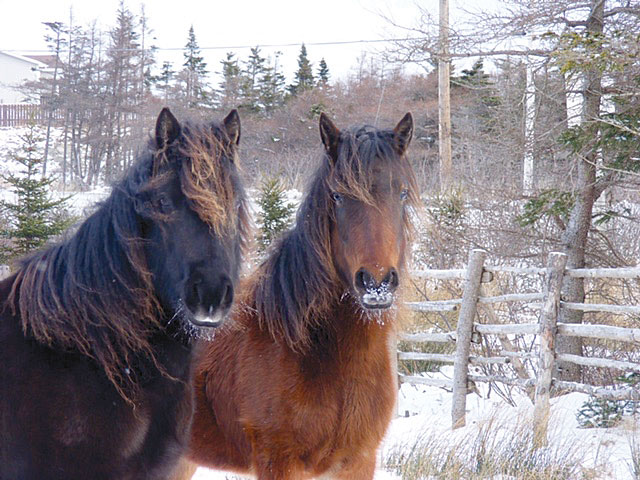
THE HISTORY
As long as there have been Newfoundlanders in Newfoundland, there have been ponies assisting them in their labours. The Newfoundland Pony is descended from Exmoor, Fell, Highland, Welsh Mountain, Dartmoor and Connemara ponies which were brought over to Newfoundland with early settlers.1 The Newfoundland Pony was originally selected for its endurance, hardiness,15 good natured gentleness, obedience, willingness and cooperative abilities. It was also well known for its strength, stamina, longevity, intelligence, common sense and versatility; as well as its ability to thrive on rough grazing.2 Evolution gave these ponies strong legs that were close together so they could travel narrow paths freely, a heavy coat, thick mane and low set tail to protect against the harsh Newfoundland winters and a sure-footed, flint hard hoof which allowed for easy traipsing of rocky ground.c
The ponies worked mainly in the fall, winter and spring when they hauled caplin and seaweed, ploughed gardens,c hauled firewood, towed fishing nets, carted produce. They also provided year-round transportation for families as the Newfoundland Pony is strong enough to carry both children and adults and is highly valued for light draft work, driving and riding.2 In the summers while the owners were occupied at sea the ponies were turned out into open spaces and were allowed to roam freely and breed.c
BREED GUIDELINES
The guidelines for the breed as set out by the Newfoundland Pony Society are that any registered pony must demonstrate and/or have documented ancestry to the Newfoundland Pony, a good temperament, be docile and easy to work with, be a good winter animal and all around hardy, be sure-footed and have a structure that can vary from fine-boned types to larger stocky types, have a height that can vary from 11.0 to 14.2 hands, have a coat colour of bay, black, brown, chestnut, dun, grey, roan or white (pink skin), have a heavy coat which sometimes changes colour and character seasonally, a thick mane and low set thick tail, feathered fetlocks with hair extending below fetlock points, flint hard hooves and typically dark limb points, though white or light colour on limbs is acceptable.d
PONY POPULATION
In 1935 the Newfoundland Ponies numbered close to 10,000 and continued to maintain healthy numbers up to the mid 1970’s. Shortly after, the pony’s numbers plummeted to fewer than 150 listed animals of which less than 40 were breedable mares by June of 1997.e Of the 300 or so ponies that now currently remain, many are geldings and aged mares, thus the number of ponies able to carry on the breed is still relatively small.f As of a 2008 census there were a total of 361 ponies of which 248 were breedable. The majority of animals are spread over Newfoundland with 154 ponies (81 breedable), Nova Scotia with 36 ponies (28 breedable), Ontario with 110 ponies (88 breedable) and the USA with 22 ponies (19 breedable). On average over the past 10 years approximately 8 males and 10 females have been born annually for an average total of 18 foals born per year.d
SAVING A BREED
In 1995 the House of Assembly of Newfoundland and Labrador unanimously supported the efforts of the Newfoundland Pony Society to protect and preserve the pony’s place in the province’s history and future.1 In 1996 the Heritage Animals Act was passed into law, providing a mechanism to ensure the survival of historically significant animals in the province and on September 15th, 1997, the Newfoundland Pony became the first animal to be designated a Heritage Animal under the Act.1 At which point the Newfoundland Pony Society (NPS) was designated the society responsible for the preservation and protection of the Newfoundland Pony. Founded in 1979 and incorporated in 1981, the Society has worked for the preservation of the Newfoundland Pony in a number of ways. It has established a Registry to record all animals and matings, put out publications, and successfully promoted the idea of the Heritage Animal Act.1 The Society is also responsible for defining the characteristics which identify the Newfoundland Pony, maintaining the legal Registry, advising governments on the future of the pony and being involved in the restriction of the export for non-legitimate purposes of the Newfoundland Pony. This means in particular that disposal of ponies to the meat trade will stop.1 As mentioned previously the Newfoundland Pony itself is not officially recognized as a “breed” and is instead considered a pony “type.”14 Part of the goal of the Newfoundland Pony breeders is to obtain purebred status for the Newfoundland Pony under The Animal Pedigree Act (APA) of Canada. An ongoing effort on the part of concerned individuals has stabilized the Newfoundland Pony population. However, the Newfoundland Pony continues to be classified as critically endangered by Heritage Livestock Canada.14
HOW IT HAPPENED
The rapid decline of the Newfoundland Pony may leave one wondering what led to the breed’s demise and why, with current technology such as Artificial Insemination (AI) and cloning, this breed is still so critically endangered. There are a number of factors that led to the breed’s rapid decline including machinery taking over the jobs once performed by the ponies, municipal by-laws limiting breeding and the availability of pastures, owners being encouraged to have stallions gelded and the selling of ponies for meat.d However, it is believed the most instrumental of these was the lack of perceived usefulness and a belief that they were of little value in the modern community, where it is more and more difficult to make money from horses and ponies.h There has been a lot done with regards to re-establishment of the Newfoundland, however the problem remains that the government and special interest groups sprung into action when the numbers became critically low, making it near impossible to increase numbers (the number of horses/ponies unable to breed or passing away outnumber the number of newborn ponies). A second issue is the cost of expanding the gene pool as the ponies are now scattered across Canada and the US and the reluctance to use AI (primarily due to cost) makes it near impossible to produce more pure-bred Newfoundland Ponies. Difficulties of registering purebred ponies has also made it difficult to know truly how many ponies there are.h
CAN TECHNOLOGY HELP?
Cryopreservation schemes, including AI, can serve as a useful backup for conservation methods in many species.10 Artificial Insemination is the injection of semen into the vagina or uterus other than by intercourse.7 In terms of horse breeding it is the use of collected semen which is then placed into straws and then used fresh or frozen to breed mares, which may or may not be in the vicinity of the stallion which was collected. There are a variety of reasons why equine AI is used, including primarily the removal of geographical restrictions as chilled and frozen semen can travel from one location to another (including internationally), the ability of a stallion to breed more then one mare per collection, and the development of gene banks for future reintroduction of genetic material.4 Cloning is one of the newer techniques of potential value to breed conservation. The greatest advantage of cloning is it can quickly spread genetic merit through a population10 by adding new individuals to the dwindling gene pools.9 The success of this new method shows promise for rescuing rare and endangered species;9 however, it does require a high level of technical expertise and an organized testing system.10 Both AI and cloning require a large investment of time and money in order to function properly and be of any use. Sadly, funding agencies seem to show a preference for projects using sophisticated technology, almost regardless of the outcome.12 Thus, even though biotechnology (AI and cloning) offers opportunities for preserving genetic resources, there is the argument that biotechnology is too often influenced by private interests, and these interests are often incompatible with ecologically sound and socially just agriculture.10
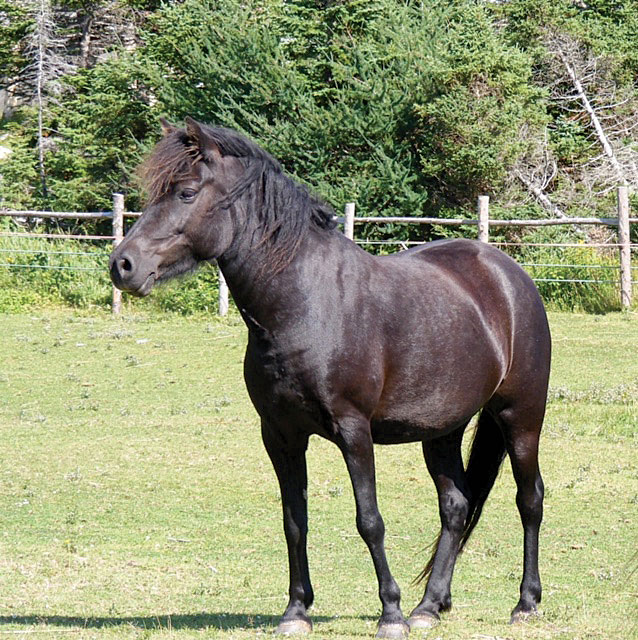
IMPLICATIONS OF OTHER BREEDS
The time has come to stop thinking of horses as a “rare” novelty and begin looking at them as an endangered species.b What has occurred with the Newfoundland Pony, and a number of other breeds such as the Suffolk, could easily happen to many of the common horse breeds that we know today if people are not made aware of the issues surrounding the resulting endangerment of those breeds. Many of the breeds that have already gone extinct, or are endangered, are actually founding breeds of other breeds that are in turn becoming endangered themselves. For example, the Dartmoor, Fell and Highland ponies were all founding breeds of the Newfoundland Pony, all of which are in some form of endangerment.b Within the context of horse populations and breed conservation, genetic characterization is the first step in developing proper management strategies.6
The loss of genetic diversity is a common outcome faced by minor breeds. Typically, minor and rare breeds are represented by a small number of breeding animals and the rate of inbreeding is directly proportional to the inverse of the number of breeding males and females.e Inbreeding is the breeding of related animals, such as father/daughter, mother/sons, brother/sister or cousins. An inbreeding coefficient provides the probability that any gene pair will be identical by descent (homozygous). For intensely inbred breeding groups, such as those represented by a small number of breeding animals, the immediate aim is to select matings to maintain a maximum of genetic diversity or low inbreeding coefficients.13 There can be severe negative effects if inbreeding is not managed correctly. Inbreeding depression, on traits that are closely related to fitness, fecundity, and survival, are well documented in wild and captive populations.3 The issue of inbreeding happens similarly in major popular breeds and commercial lines, where few sires are extensively used to produce future generations and breeding stocks, plus a breeding system inductive to inbreeding, thus the outcome of inbreeding is two fold.e Along with a small population also comes the issue of bottlenecking, which results from a period of severely restricted population size in the history of a breed.13 Although the population may later increase, the loss of the genetic diversity carries through; certain genetic combinations may have been lost forever.10
One issue surrounding genetic diversity which is less reliant on population size, but plays a major part in genetic variation, is that of breeding management, an issue relevant to all horse breeds. Breeding done in pasture by free live cover, as done in many native horse/pony breeds, results in a lower level of genetic diversity because only one stallion per year per herd is used. In comparison, when breeding is mostly done by hand cover with different males used almost each year and more then one per herd, genetic diversity and thus genetic conservation increases greatly.5 In our modern day genetic conservation it is not even considered as a factor, as many horse owners are more concerned with individual conformation and temperament than with any breed designation.
Looking at historical data the diversity of horse breeds declined with increasing mechanisation.10 Before mechanisation horses were put to a variety of uses and their use was very much related to their capacity for adaptation and endurance under specific conditions.11 However, since no horse could “work day and night for months without stopping” like a steam engine, it was apparent that a “one horse engine could do much more work than any other such horse.” Pumping machines and factories that ran machinery required lots of horsepower for long periods of time and these switched to steam first.8
The Suffolk for example was descended from the great warhorses of medieval times. In the First World War these powerful giants were used to haul the guns and medical wagons. For generations, they had also been used to work the land, but with the mechanization of agriculture it has eliminated the need for them and led to a severe decline in populations of the breed,g similar to the downfall of the Newfoundland Pony.
Money and politics amongst governments and conservation groupsh continues to be the biggest hindrance. This does not apply to only the Newfoundland Pony or just to the endangered breeds, but is a very real problem for even the most common breeds. Specifically to the Newfoundland Pony is the issue over what constitutes a purebred pony, who should handle the registry and lack of money to promote the breed.h Another issue applicable to many breeds is the lack of perceived value (people undervaluing, feeling that “who wants them they are too small, etc.” with the trend towards imported horses such as Warmbloods, which can generate a lot more money for a horse breeder).h Animal breeding is a business and it is becoming increasingly apparent in both Europe and in North America that if many of these rare breeds are to be conserved they must be demonstrated to be of some economic value.10
THE EFFECT OF INDUSTRIALIZATION
Since the dawn of humanity, animals have been used for work, but over the past century, with increasing mechanisation, the animal work force has dwindled.11 Availability of free time to the human work force has increased as a result of the recreation reform movement which began as a response to social dislocations resulting from this mechanization, better known as industrialization. Recreation is seen as part of a work-recreation-work cycle and is dependent upon work for its meaning and function.16 With the blossoming of recreation came the use of animals for sport and recreation, which took on a significantly greater importance in the survival of many horse breeds.11
Industrialization as it turns out was both a help and hindrance to the horse and has become the saving grace for many horse breeds. As mentioned above, industrialization saw the phasing out of real horse power for more efficient mechanical horsepower and as a result many horse breeds found that they no longer had a use in the modernized world. Because of the increased efficiency the people found they had more free time to relax and be entertained. As part of this entertainment many of the horse breeds, which found themselves without a use, soon found a new niche. Thoroughbreds and Standardbreds, once carriage horses for example, were now being used as racehorses for people to bet on. Draft horses, like the Clydesdale, once used for ploughing the fields, were now being used as parade animals or to haul barrels of ale. If recreation had not developed the way it did, and if many of the breeds had not found a new niche, how many more breeds would now be endangered like the Newfoundland or the Suffolk or even worse, extinct? In our fast developing world rural and academic environments have undergone significant changes in the latter 20th and early 21st centuries. Agriculture, for example, has become increasingly specialized, commoditized, and industrialized, with consequent environmental and social impacts prompting a movement toward smaller-scale, more diversified and quality-oriented farming systems,2 such as organic farming and trends back to the old ways of doing things.
BREED VIABILITY
As is the case with any endangered breeds, the long-term viability of these breeds is difficult to guarantee if they do not serve a useful purpose. Breeding to maintain an animal as a living museum piece or as a testimony to times gone by has proven not to be a tenable proposition.f These endangered breeds need to find new roles in the contemporary countryside and in the new economic order. This has been identified as the key to their chances of survival.2
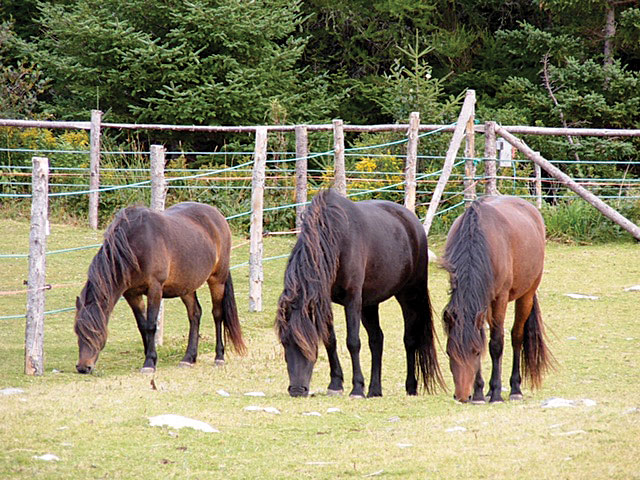
CONCLUSION
What is needed to ensure the survival of breeds in the future, at least in Canada, is a federal government program to record and track populations of older farm animal breeds, stakeholder involvement and coordination at the national level, support for farm animal conservation efforts including incentives and subsidies for keeping threatened breeds, systematic programs to preserve genetic material, and structured breeding programs adapted to low external input, along with conservation programs. A clear statement regarding the benefits of conserving animal genetic resources2 and an increase in public awareness is also needed and has been greatly lacking. More research needs to be done in the area of domestic animal conservation, including that of all major and minor horse breeds.
Many horse breeds were saved by the development of recreation during the industrial revolution, but it must be remembered that any of those breeds could have easily been in the place of the Newfoundland Pony and thus should be counted lucky for the time being, as being a domesticated animal in our everchanging world does not necessarily ensure safety.
ADDENDUM
This article was written as a research paper in 2011 for an Equine Trends & Issues course as part of the BBRM Equine Management Degree through the University of Guelph (Guelph, Ontario). Some numbers and data cited may have since been changed and/or updated. This does not change the importance of the topic covered or its importance in the future, not only of horse breeds but all heritage breeds.
REFERENCES
• a) www.allaboutwildlife.com/endangered-species
• b) www.equus-survival-trust.org
• c) http://www.equiworld.net/newfoundlandpony/index.htm
• d) http://www.newfoundlandpony.com
• e) http://npba.ca/history.htm
• f) http://www.deerfieldfarm.ca/nfldpony/nfdlpony.html
• g) http://news.nationalgeographic.com/news/2001/05/0522_suffolkpunch.html
• h) personal communication (Feb 2011)
• 1) Animal Health Division. The Newfoundland Pony: A Heritage Animal. St.John’s (NL): Department of Natural Resources; 2010. 2 p.
• 2) Sander-Regier R M. Resistant, Flexible, Diverse: Revaluing Rare Farm Animal Breeds As Countryside Capital, Journal of Rural and Community Development 2010; 5 (1): 36-57.
• 3) Thirstrup J P, Bach L A, Loeschcke V, Pertoldi C. Population viability analysis on domestic horse breeds, J. Anim. Sci. 2009; 87: 3525-3535.
• 4) Davies Morel M C. Equine Reproductive Physiology, Breeding and Stud Management. Wallingford (UK): CABI; 2008. 378 p.
• 5) Luis C, Cothran E G, Do Mar Oom M. Inbreeding and Genetic Structure in the Endangered Sorraia Horse Breed: Implications for its Conservation and Management, Journal of Heredity 2007; 98 (3): 232-237
• 6) Plante Y, Vega-Pla J L, Lucas Z, Colling D, De March B, Buchanan F. Genetic Diversity in a Feral Horse Population from Sable Island, Canada, Journal of Heredity 2007; 98 (6): 594-602.
• 7) Oxford Canadian Dictonary. 2 ed. Don Mills (ON): Oxford University Press; 2006.
• 8) McShane C, Tar Transportation History 2003; 24 (2): 177-198.
• 9) Lee K. Can cloning save endangered species?. Current Biology 2001; R245-R246.
• 10) Patterson D L. Is there a lifegaurd at the gene pool?, Can J Anim Sci 2000; 80: 245-255.
• 11) Kaushik S J. Animals for work, recreation and sports, Livestock Production Science 1999; 59: 145-154.
• 12) Ruane J. A critical review of the value of genetic distance studies in conservation of animal genetic resources, J Anim Breed Genet 1999; 116 (1999): 317-323.
• 13) Bowling A T. Horse Genetics. Wallingford (UK): CABI; 1996. 200 p.
• 14) Fraser A F. Alderson L, Bodo I, eds. Genetic Conservation of Domestic Livestock, Volume 2. CAB International, Oxon, 1992, 282pp. ISBN 0-85198-809-1, Can Vet J 1994; 35: 385-386.
• 15) Cregier S E. Fraser AF. The Newfoundland Pony. Creative Publishers, St. John’s,1992.213pp. ISBN 1-895387-14-0, Can Vet J 1993; 34: 542.
• 16) Smith S L, Godbey G C. Leisure, Recreation and Tourism, Annals of Tourism Research 1991; 18: 85-100




